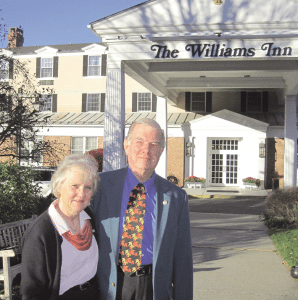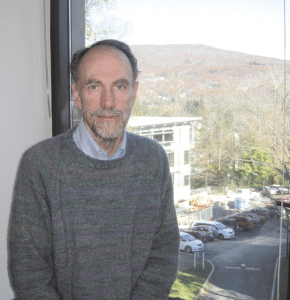Community Profile
Culture, Education Boost Business in Williamstown

Carl and Marilyn Faulkner have survived myriad setbacks in the tourism industry to remain a regional draw.
His name, however, is engraved inside a New York Yankees World Series ring on display in an antique curio cabinet in the great room of the Williams Inn, on the green in the heart of Williamstown.
Faulkner and his wife, Marilyn, have been the inn’s proprietors since 1979, and the ring is just one of many mementos that validate just how respected the the couple is by thousands of tourists who have visited the area, famous thespians who have performed in the Williamstown Theater Festival, and students and alumni of Williams College, located mere yards away.
“I’ve never been to a Yankee game, but for 30 years I knew George Steinbrenner because he used to come for his college reunion. He said he was fed up with Cooperstown and wanted the fans here to be able to see and touch a real ring,” Faulkner said, adding with a sly smile that he believes Steinbrenner added Faulkner’s name to the ring to deter him from selling it.
All who know Carl Faulkner know he would never do such a thing, but the dry humor and easy demeanor are among the many reasons he and Marilyn have attracted so many return guests, both celebs and regular folks, to this small town on Route 2, the famous Mohawk Trail.
Whether for a Williams College reunion or commencement, a play at the famous Williamstown Theater, a visit to the Sterling and Francine Clark Art Institute — known affectionately as ‘the Clark’ — or an exhibit at the Massachusetts Museum of Contemporary Art (MASS MoCA) in nearby North Adams, Williamstown isn’t easy to get to, but legions of alumni, and fans of culture and natural beauty, think the town and its unique attributes are well worth the trip.
In fact, those making the trek from the Mohawk Trail, or the Mass Pike and Route 7 from the south, can currently see economic development in progress on the Williams campus and at the Clark.
James Kolesar, vice president for public affairs at Williams College for the past 29 years, told BusinessWest that a new, three-story Sawyer Library, now under construction, will replace the original, soon-to-be-demolished library, located about 50 yards away, making way for a formal quadrangle. Throw in the massive, three-year, $50 million renovation and expansion project at the Clark, which should be complete by the end of 2014, and there is a firm foundation for economic growth in Williamstown.
“Our academic reputation is a draw, certainly, no question about it,” said Kolesar, noting that Williams stacks up well in stature with Harvard, Yale, Dartmouth, Brown, and archrival Amherst College. “With our 1,000 employees and operating expenditures of more than $190 million, that’s $82 million in capital improvements from us, plus the Clark improvements.”
Williamstown is not without its issues, however. The Great Recession affected businesses here much the same as in other Western Mass. communities, and when Hurricane Irene struck in 2011, a popular mobile-home park was essentially wiped out, further shrinking an already-low inventory of affordable housing.
Meanwhile, the aforementioned new economic development and ongoing roadwork — courtesy of the federal stimulus program — will be positive for the town in the long run, but Faulkner calls the disruptions they cause in the meantime “medicine that has to be swallowed” (more on this later).
But the biggest challenge this town of 7,870 residents (2,000 of whom are Williams College students) faces, according to Town Manager Peter Fohlin, isn’t what one would expect — it’s a lack of land. Specifically, “we don’t have enough developable land for me to respond to inquires I get.”
The issue, he said, isn’t due to infrastructure or the mountainous terrain surrounding the town, but the fact that a collection of successful farms, producing mostly cattle for beef and not available for sale, comprises much of the usable land.
For this month’s Community Profile, BusinessWest ventured to the most northwestern point of the Commonwealth to learn more about the business life of Williamstown and how the community, even with the logistical challenges of its far-flung location and lack of buildable land, is making the most of its educational, cultural, and natural advantages.
Cultural Values
Like Carl Faulkner, Fohlin has his own sense of humor. He proudly states that Williamstown isn’t that remote, but, rather, “centrally located four hours from everywhere.”
Fohlin’s ability to make fun of himself in his municipal position — in which, he says, he’s often dodging verbal bullets — is on display each year for the Fourth of July parade.
“Instead of Peter being in front waving, he’s at the back behind the horses with a shovel and a broom,” said Marilyn Faulkner, laughing. “That’s the kind of guy he is.”
That upbeat attitude will help as Fohlin, the five-member select board, and other departments in town seek to replace its outdated high school and police and fire stations, among other issues. While citizens are “engaged in lively debate over priorities and affordability” when it comes to municipal needs, he said, Williamstown has a lot on its plate for a small community.

James Kolesar says Williams Colleges provides an excellent educational and cultural anchor for business in Williamstown.
But the swift floodwaters from Irene severely damaged 160 of its 225 mobile homes; almost 5% of Williamstown’s non-student population was made homeless in a day. Fohlin said the remaining homes will ultimately be moved because they are in a flood plain, and the housing authority is working on a 40- to 60-unit project for those living temporarily with family or friends.
Kolesar said the loss of the park damaged the town’s socioeconomic diversity, which is already lacking for a combination of reasons, among them fewer jobs for young people, which keeps them from returning after high school or college graduation, as well as increasing real-estate costs.
The town does boast a significant percentage of second homeowners, and some, Faulkner said, are faces that might not be familiar, but as CEOs of major corporations or notable alumni, their names certainly are. “It’s such a desirable place to live, and that drives the property values up,” added Kolesar.
Road Well Traveled
The guest ledger at the Williams Inn, especially from Clark visitors, has been truncated for the past three years due to the massive expansion project. The final phase includes construction of a new visitor, exhibition, and conference center, as well as a comprehensive landscape plan for the 140-acre property. During this period, the Stone Hill Center on campus is housing some of the more famous works, but several others have been loaned out to other galleries across the nation for the duration of construction.
“It makes me cry,” Carl said, feigning the wipe of a tear from his cheek. “We are usually busy for lunch, but it’s been much less so over the past couple years, and with this most recent two-week closure, we had almost no one.”
But the Faulkners are no strangers to setbacks; it’s just part of the tourism industry. Hoteliers all their lives in New England, they suffered through the 1970s gas shortage, and 9-11 slowed all tourism in the U.S., but the tightening of the American and Canadian borders by Homeland Security has caused problems with bus tours, he said. Canadian bus-tour companies now encourage Americans to fly to Canada, skipping American border-security checks and, as a result, bypassing the Berkshires region, Williamstown businesses, and the Williams Inn.
Amid the recent Great Recession, visitorship was also down, and then the federal stimulus to create jobs offered many towns funds to improve roadways, which tore up Main Street and the green in front of the inn for almost two years. When Irene’s rains took out the Spruces, the Mohawk Trail — the most scenic route into town — was also massively damaged.
But the innkeepers remain upbeat, replacing those missing customers with tourists from Europe and Australia, and are focusing on the region’s residents with seasonal events like the German Oktoberfest they recently staged for hundreds of attendees over a two-week period. Next up is a month and a half of holiday programming, which has always proven popular.
Good Company
Fohlin and Kolesar both say Williamstown’s selling points reflect the American Dream — a town that is safe, has an excellent educational system (the Mt. Greylock Regional School District), and little traffic in the real sense of the word.
Certainly, Williams College remains one of the main draws in town, and Kolesar sees the institution as the main anchor of business in the Williamstown area — economically, culturally, and socially.
Yes, prospective students who appreciate city life might see four years in this remote area of the Northern Berkshires as a deal breaker. “But, for some students, it’s a plus,” said Kolesar. “By and large, students who end up coming here end up falling in love with the area, not just the college.”
Faulkner agrees. “The college is like having a good uncle in town,” he added. “And we do have a strong feeling that better days are ahead.”
Elizabeth Taras can be reached at [email protected]




